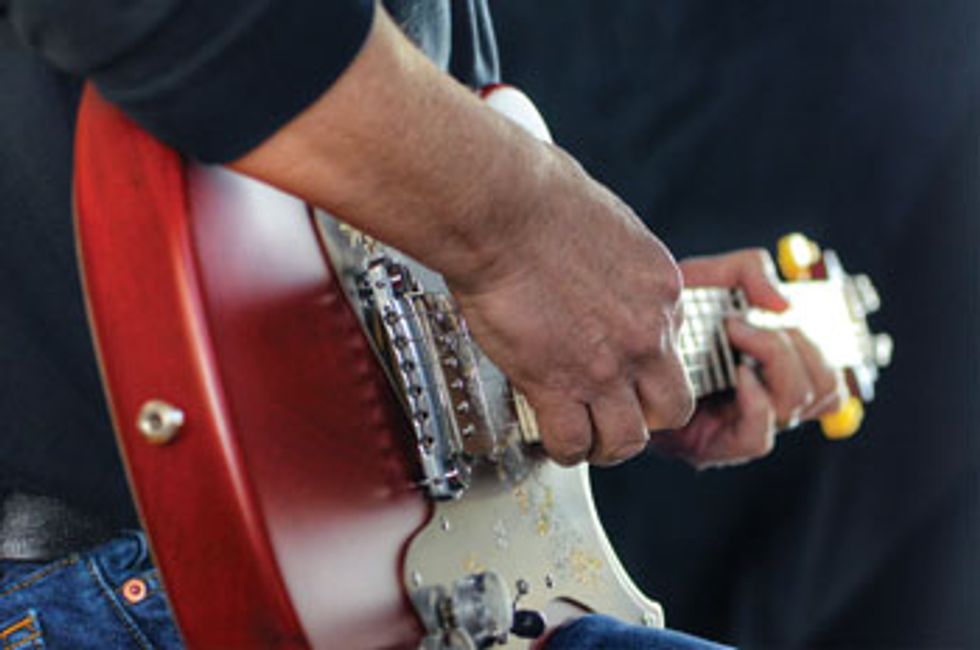
Even the most advanced technology cannot replicate the organic, physical connection you feel when you have your hands on strings and wood.
Make no mistake. The title of this column is “Esoterica Electrica,” which by some inference refers to guitar technology. Right now, I’m sitting in a café typing on my MacBook, which is connected to the cloud via Wi-Fi, fiber optics, and satellite links. When I’m finished, I’ll fire this piece off in an email along with some images I made with my digital camera and edited in Photoshop. You’re probably reading all this on a computer, iPad, or cell phone.
Digital technology is now a part of almost every step in the music-making process too. So what does this have to do with guitars? Analog instruments are links to our most basic and real selves. When the pace of technology saps our strength and leaves us overwhelmed, closely holding some wood and wire and banging out some guttural tones is more than just a mere distraction.
Technology isn’t new to musical instruments. As quaint as it seems today, the European-style violin was super high-tech when it was developed in the 15th century. The modern piano came of age in the 18th century when the dynamic keyboard was perfected. It too was cutting-edge stuff at the time. Of course, the electric guitar was a variation on its acoustic predecessor—developed to take advantage of 1930s amplification devices. And around the same time, the electromechanical Hammond organ led the way for the synthesizers of the 1960s to be adopted into modern music.
In some ways it seems that technology in music has been on a steady march, and quite possibly at the leading edge of change. But at some level, musical instrument technology is different from, say, communications equipment. There are objective goals in many arenas that can be measured by speed and efficiency. No one denies that the first car across the finish line is the winner. But much like figure skating or dance, music isn’t just about how high you jump. And although developments in gear may make it easier to achieve a desired result, that result can’t always be measured with a stopwatch or seen on a spreadsheet.
Consequently, the electric guitar has reached a point similar to the “classical” instruments that preceded it, locked in time and subject to only minor variations. The use of 7-, 8-, and even 10-string guitars is merely a throwback to 16th-century lutes, which sported at least eight courses of strings. In one of the biggest changes in decades, the 1980s saw the development of the locking tremolo, which did broaden the range of techniques a player could employ, but didn’t really change the form. Switching systems, external tone-modification devices (stompboxes), and even digital modeling have been added as peripheral gear, but have not really altered the instrument itself. Throughout all of these changes, the basic format of the instrument has remained constant. What’s up with that?
When you strap on a guitar and strum it, you are transported to a place that even the most modern technology cannot take you. It’s a direct link to all that has come before you. A few minutes of playing guitar is like visiting with your heroes and paying homage to the human experience all at once. Chasing the sounds that captured your imagination as a kid, and making noises that bring those memories into the present and beyond, places us firmly into a continuum that underscores what it is to be alive. Having your hands on strings and wood that vibrate against your body is a primal conversation between you and the universe. It’s the direct, physical connection that computer-driven touch screens don’t provide.
The interest in vintage instruments underscores this belief. Guitars with history have experience that technology cannot replicate. When I build an instrument, I’m thinking about all of this, and I know a few builders who do the same sort of thing. I’m not making a toaster. I’m crafting a tool for communicating with your imagination, and every choice I make is aligned on that goal. Because playing a guitar is so personal, its creation has to be personal too. If technology is a part of that, fine. But I usually find that the more sweat I use, the better the result. I suppose someone will make the argument that even we are ones and zeroes at the atomic level, but for me, the buck stops here.
This isn’t intended to be a concise history of musical instruments. I’m merely pointing out that every era produces hallmark gear. Those that survive seem to become frozen in amber, only open to small refinements in design. Meanwhile, there is no shortage of modern technology surrounding the cast of musical characters. Despite the onslaught of digital technology in recording, mixing, and distribution of music, the instruments we hold to our bodies and strum seem resistant to it. It’s a way of getting off the fast track and holding on to what’s real.
 Jol Dantzig is a
noted designer, builder,
and player who co-founded
Hamer Guitars,
one of the first boutique
guitar brands, in 1973.
Today, as the director of
Dantzig Guitar Design, he continues to
help define the art of custom guitar. To
learn more, visit guitardesigner.com.
Jol Dantzig is a
noted designer, builder,
and player who co-founded
Hamer Guitars,
one of the first boutique
guitar brands, in 1973.
Today, as the director of
Dantzig Guitar Design, he continues to
help define the art of custom guitar. To
learn more, visit guitardesigner.com.






![Rig Rundown: Russian Circles’ Mike Sullivan [2025]](https://www.premierguitar.com/media-library/youtube.jpg?id=62303631&width=1245&height=700&quality=70&coordinates=0%2C0%2C0%2C0)

















